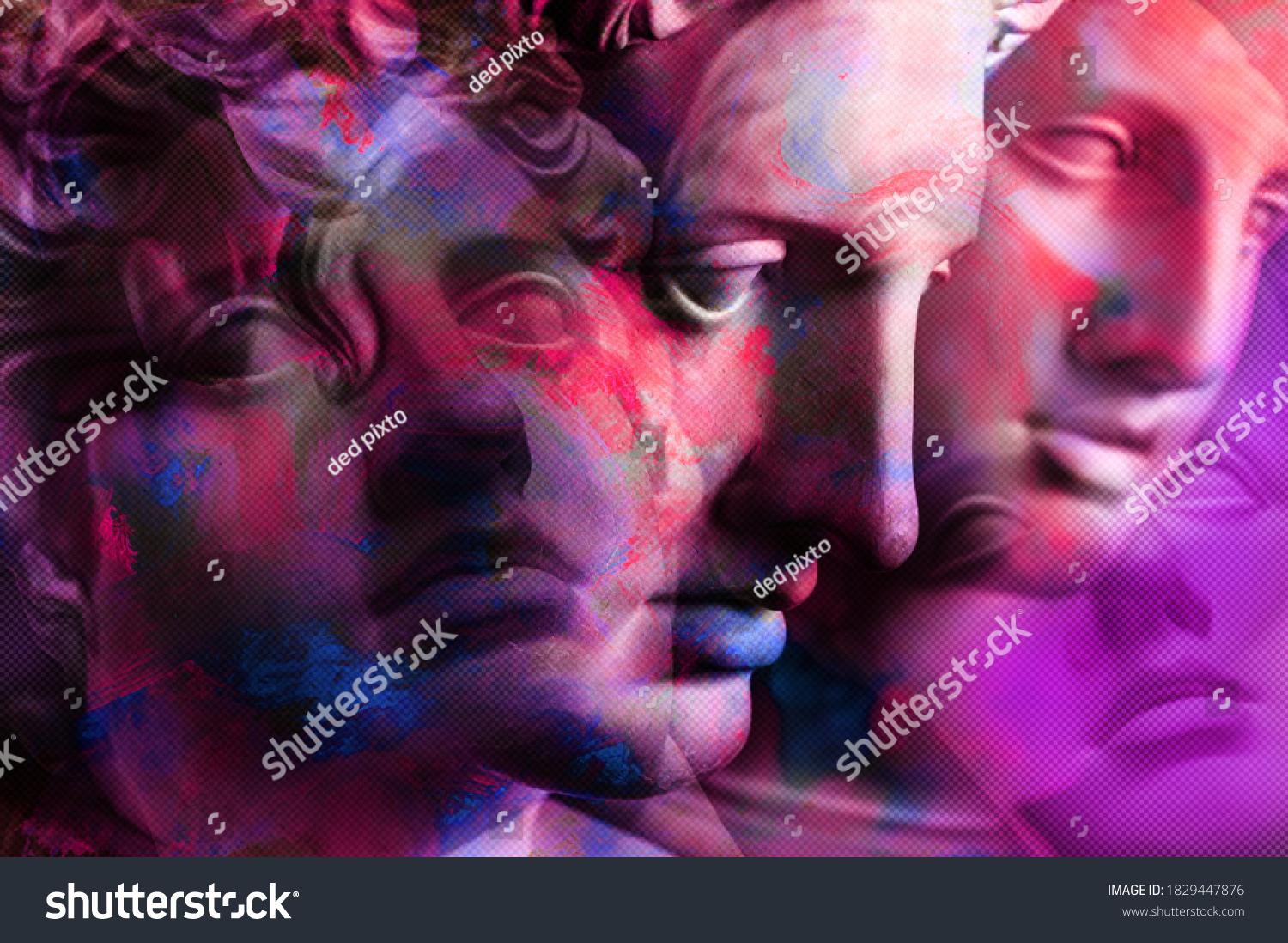Welcome to Design History and Theory. As you progress through this topic, you will learn about:
- Where did design begin?
- The Industrial Revolution
- Historical design movements
- Current design trends.
Terminology and vocabulary reference guide
Working in a design environment, you need to be familiar with terms associated with principles and use the terms correctly (and confidently) with clients, your colleagues, and other industry professionals. You will be introduced to many terms and definitions. It can come handy to start a vocabulary reference guide by adding any unfamiliar terms into a notebook or a Word document.
Activities
There are activities within this topic and an automated quiz at the end of this topic. This is not part of your assessment but will provide practical experience that will help you in your work and help you prepare for your formal assessment.
Design is more complex than simply throwing together a few elements for a pretty visual. Some of the most influential design movements that have occurred, was due to what the design was being communicated as well as the skills that were involved to create it. To truly understand design and design skills, it is imperative to first understand the history and theory of design. It is significantly important for designers to see the value of how history can influence their work and facilitate reaching the goal of what is trying to be communicated within a design.
Let’s go back in time to the very beginning where it all started to see how design has evolved and the creative industry has taken shape.
Cave paintings: The first illustrated graphics
Design can date back as far as 4000 BC, to the cave painting days. Primitive cavemen would use the natural Earth’s resources creating colour to illustrate life as they knew it. Cave paintings most often would represent the spiritual beliefs of primitive people, such as the famous Lascaux Caves. Similarly, Australian Aboriginal cave paintings are about their ‘Dreaming’, their spirituality. They would produce drawings of spirit people, animals and hunting, along with other graphics across cave walls. In a way, their designs can be viewed as a way to photograph the moments in their life. Their designs would be easy to understand. This oldest form of communication gives designers a very important lesson, one that will pave the way for many future designs. That is the importance of communicating clearly through the use of design.
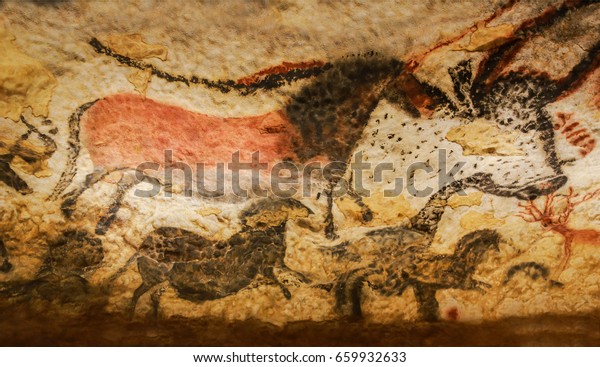
Pictographs: The first written language
Centuries later, the first sign of written language was seen in 3100 BC, using pictographs. These pictographs are called cuneiform writings. They are inscribed with wedged shaped tools that form the symbols into wet clay tablets. This enabled designs to communicate clearer through non-verbal symbols, which further evolved into written language as we now know it. The represented objects became a form of visual shorthand, and these shorthanded symbols became the commonly used symbols, originally used in agricultural commerce.
Pictographs originated in Mesopotamia and were also introduced into Egypt where people used pictorial symbols for a word or phrase.
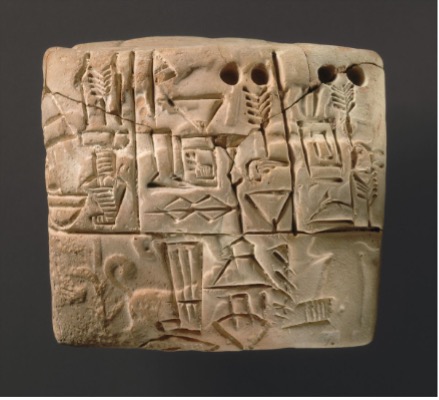
Illustrated manuscripts: Layout of illustrations and pictographs
Egyptians used a combination of painting visuals and pictographs to tell a story. A common illustrated manuscript belonging to the Egyptians is known as The Book of the Dead that dates to 2340 BC. These images were produced to smooth the way for the dead, particularly the Pharaohs into the afterlife. When viewing the scene of the illustrated manuscript, it resembles a modern-day magazine. For instance, it has the main image in the centre and the communicative pictographs wrapping around the outside. The Egyptians were excellent in graphic design and used the principles of hierarchy and balance to great effect. It is easy to see that designers can easily draw inspiration from these manuscripts in today’s current design practices.

Chinese relief printing: printing for mass production
Between 2000-1000 BC, the Chinese were etching into materials such as jade, wood, ivory, gold, and more commonly, stone. Once the material had its etching, ink was rubbed on it, making it possible to print on cloth and later, paper. With the development of relief printing, where individual carved wooden blocks were used, it enabled the various texts to be communicated among a larger audience. 2
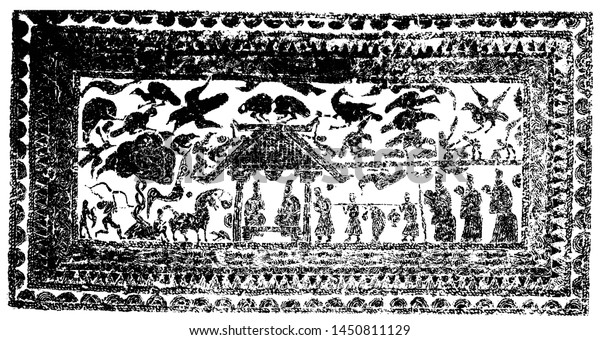
The invention of paper
It was not until 105 BC, that Ts’ai Lun invented paper. By experimenting with the bark of Mulberry Trees and then Mulberry bark and rags he created paper, which has evolved over the centuries to what we understand to be paper today, with its inherent mass production qualities and quantities.
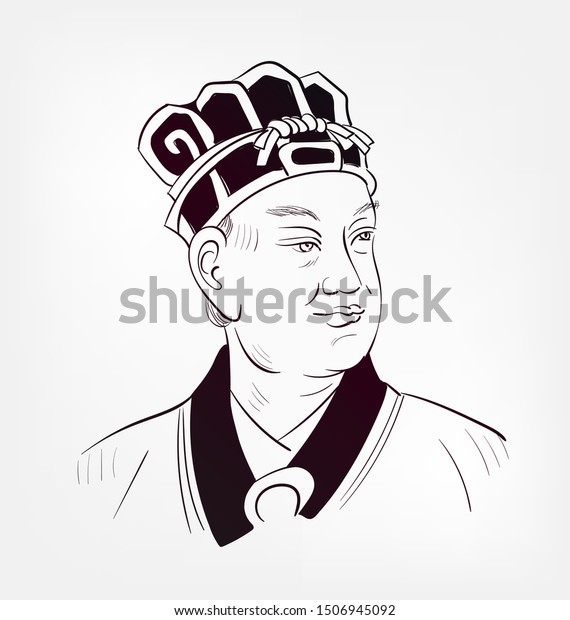
Illuminated manuscripts: Medieval era
Between the centuries we have seen colour and detail transform through human inspiration. In 400 AD, existed illuminated manuscripts that are a perfect example of this. Typography and art have started to merge. Illuminated manuscripts, which most civilisation’s produced, were the preserve of their church and their literate elite. In the Western world, scribe monks worked tirelessly to reproduce both the text and illustrations of already existing manuscripts. These were often very lavish in the materials used such as gold and silver on Vellum which was prepared animal skins. Paintings and sculptural friezes in churches told the stories to the illiterate masses. This moment in time also acknowledges the development of written language being displayed in the manuscripts.
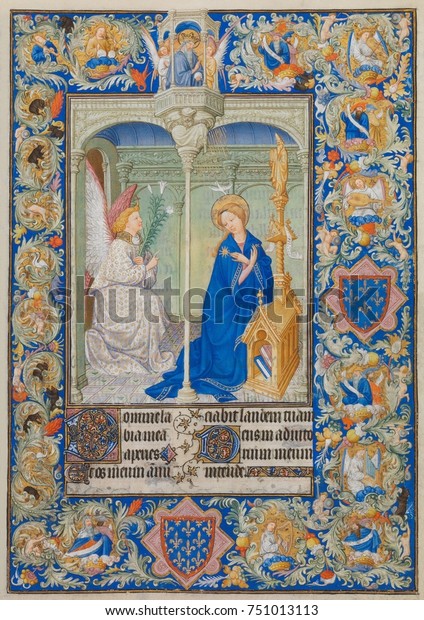
Printing: Movable type
The Chinese predominantly used whole block, which was an economic method for mass printing. Until, between 990-1050, Bi Sheng invented movable type. He developed baked clay blocks, albeit very fragile. These individual blocks of carved Chinese characters enabled rearrangement of various messages to facilitate better and easier mass production printing.
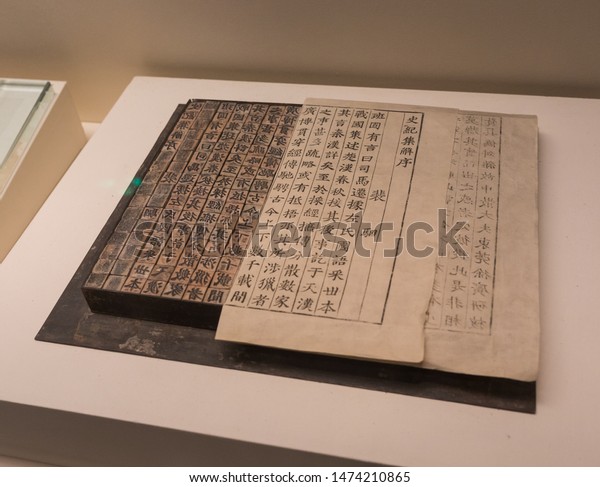
Printing: Gutenberg’s printing press
Johannes Gutenberg, a German goldsmith, invented a printing press in the 1400s. Gutenberg designed and developed a wooden printing machine. Ink was applied to the moveable type and paper was positioned on top of that, then a flatbed was lowered which exerted pressure onto the paper and the ink was transferred off the type onto the paper.
Gutenberg’s invention meant that printing moved away from the expensive labour-intensive handwritten books. The printing press made use of moveable components of type that could be reused several times. Gutenberg’s printing press is also remembered for the Gutenberg’s Bible. This was the first book produced on Gutenberg’s press and it gave people the ability to read and understand the written word of the Bible. 3
Consequently, as more books were able to be produced at a faster pace, they became more affordable and more accessible to people, and therefore improved the literacy levels for many.
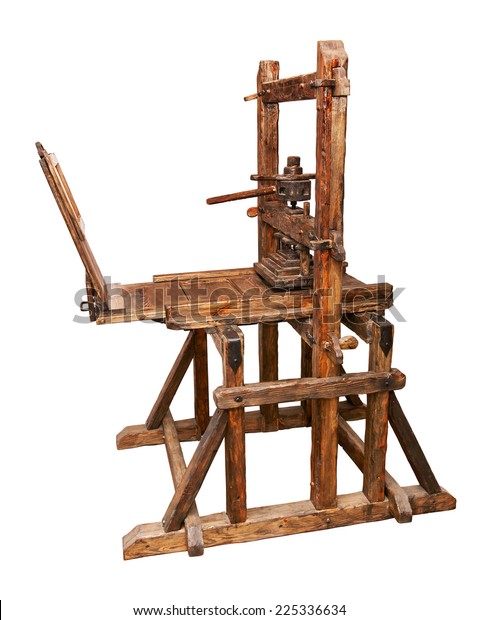
These pivotal moments have created large impacts in design throughout history. These steps were the basis and roots of future design. They have allowed the development of skills, techniques, design, typography, graphics, colours and mass production of printing to evolve. Thus, merging styles and endlessly inspiring designers.
Let’s have a look at some influential design movements throughout history and how they augmented their design styles and communications effectively as time went on.
Migration Use this code for activity
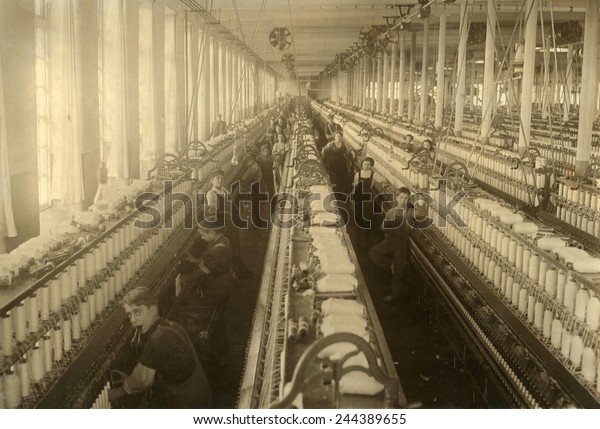
The Industrial Revolution did many great things for design. It gave the creative industry standardisation and the ability to reproduce on a mass scale. However, the Industrial Revolution, was a difficult time for the lower classes. As most people relied heavily on their physical skills and worked in agriculture, the new agricultural machinery was replacing manual labour, thus changing the social order.
The Industrial Revolution that began in Great Britain during 1760 to 1840 quickly spread throughout the world. This period significantly impacted civilisation on a global scale with new industrialisation and innovation. It included changes with machinery for agriculture and textile manufacturing and new engineering for steamships and railroads. The Industrial Revolution affected social, cultural, and economic conditions in both positive and negative ways. It was creating new ways of living, new jobs and higher incomes but also came at a cost of losing the value of craftsmanship skills, and related jobs.
Let’s have a brief look at the impact it made on some labour-intensive industries, pay close attention on how they have since skyrocketed further in today’s current industry practices.
Textiles
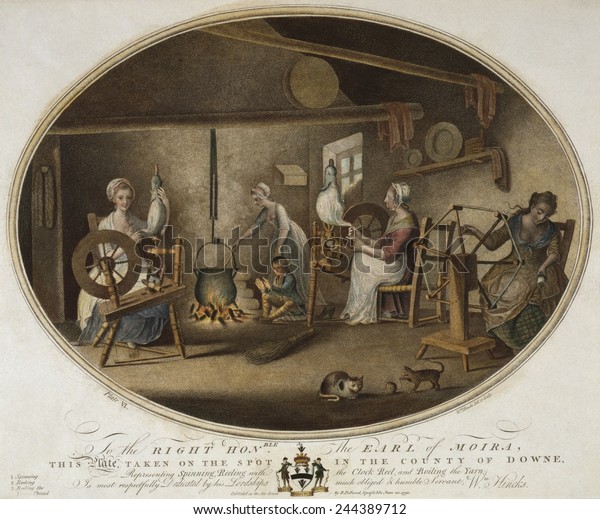
efore the Industrial revolution, textile production generally took place in small workshops or at the homes of spinners, weavers, and dyers, for example "cottage industry".
Agriculture
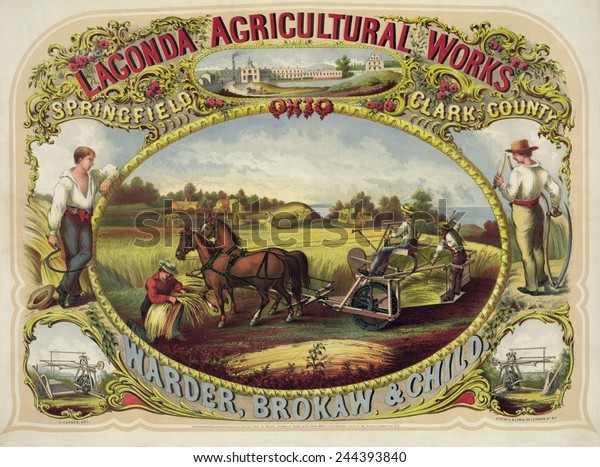
During this time, new agricultural techniques and technologies paved the way for change. In many rural areas across Great Britain, an oversupply of inexpensive agricultural labour resulted in high unemployment and rising poverty. As a result, many agricultural workers moved from farms and rural areas to towns and cities in quest of work. Working conditions in the mines and factories were neither healthy nor safe and workers were required to work long hours. The living conditions for these workers were poor, the housing being substandard and without sanitation. London streets until the late 1800s had open sewerage drains that drained into the Thames.
Steam and coal

Prior to the Industrial Revolution, power sources relied on older technology like waterwheels, horsepower, and windmills. The Industrial Revolution introduced changes in power sources such as the steam technology. Thomas Newcomen, a British Engineer invented the steam-driven piston engine in 1712. This invention made it possible to create more powerful engines in industries including coal mining, textile mills, and other heavy industries.
In the following century, in 1814, Friedrich Koenig invented the Steam Powered Printing Press. This was a more powerful and faster printing machine. Design became more necessary as technology was able to produce higher quantities. This need is even more relevant today, making design a continuous growing and evolving industry. During the Industrial Revolution, design needed to adapt to those times, likewise in the current digital culture, where there is also a need to integrate design and technology.
Printing continued evolving. Alois Senefelder invented the lithographic method of printing in 1796. This was not a steam-powered printing method but allowed for hand draw works in multiple colours to be created. One of the lithography’s greatest exponents was Henri Toulouse-Lautrec. Lautrec used the lithographic method to create his memorable posters of Paris nightclub life, particularly the Moulin Rouge during the late 1800s. Printing developed rapidly over the next decades becoming more refined and more complex.
Factories
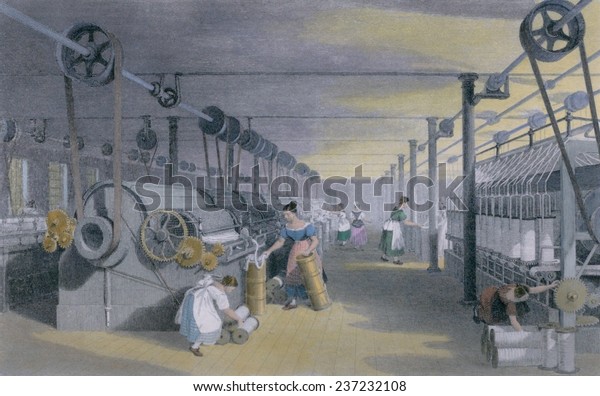
The development of steam technology, which provided a consistent supply of energy, resulted in a growth in the number of new factories, earlier known as "manufactories". The construction of vast industrial structures was used to house textiles, foundries, and metal works. Workers that moved out of rural areas to gain work in these factories had to get used to working and living in the cities under hazardous working conditions. Their new, but dirty surroundings included polluted skies and dangerous new machinery. Factories allowed unskilled people to work within their factories, children were also exploited for work in this period.
Transport
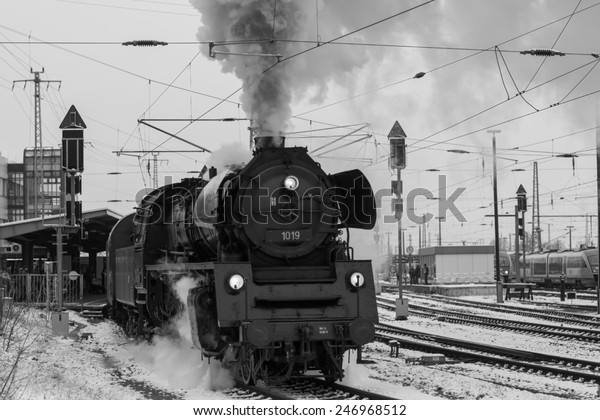
After 1750, the rising need for coal exposed flaws in Britain's river and sea transportation systems, which were sensitive to climate and tides. Mine owners (and industrial speculators) financed new canal networks to connect mines to population and industry centres due to the high demand for coal as a raw material. Canals were built first to transport coal. Once, the rail network was established, coal was transported by rail and England's railways expanded exponentially in 1800s, not only for business reasons but also, for pleasure.
Although the Industrial Revolution took place around 200 years ago, it was a period that had a significant impact on how people lived and how businesses ran. The advantages and disadvantages of the Industrial Revolution are still debated.
This movement had advanced the means to produce, transport, and communicate. Each time technology takes civilisation to another level, jobs are lost, and other jobs are created. It combines a mixture of emotions among society. There is a need to grow, improve and adapt, but also sadness at a loss of skill and lifestyle. The following table describes some of the great benefits as well as some of the significant shortcomings associated with the Industrial Revolution.
| Advantages | Disadvantages |
|---|---|
|
|
Art and design in the Industrial Revolution – How we became modern
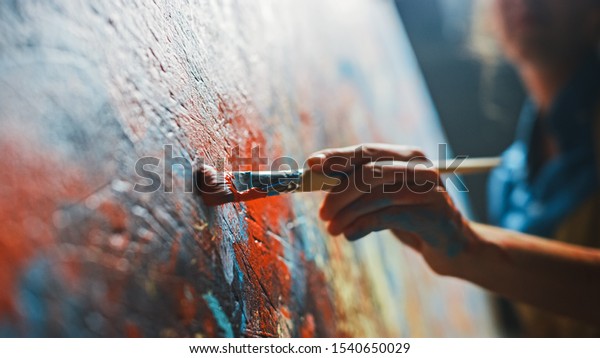
With the invention in mid-1800s of commercially available oil paints in zinc tubes, artists of the 19th. Century were free to paint ‘en plein-air', that is painting outdoors. This may also have reflected upon the importance of the invention of the camera at the beginning of the century. Photography gave people the unprecedented ability to capture scenes instantly. In a way, this made painters irrelevant as they were no longer the sole visual reporters of historic events, of portraits, of religious stories. They were now free to visualise what they saw in contemporary life and of their own inner emotions.
The Industrial Revolution also impacted the life and works of artists in several indirect ways. As railroads made long-distance travel more accessible and cities became more and more overcrowded, the impact of technology and machines on everyday life became impossible to ignore. Life seemed to be moving faster, and some artists sought to catch the fleeting moments that seemed to pass by too quickly. From the French Impressionists, who painted the fleeting effects of light and atmosphere on a landscape, to the Italian Futurists who painted the chaotic movement of a world in flux, the speed of a moving car, the dynamic of the machine age.

The 20th century is often split into two main periods in art history, where a number of distinct movements existed under the umbrellas of modernism and postmodernism.
- Modernism- began in the late 19th century and continued until the mid-1960s. Modernist art challenges formal and stylistic conventions; it questions the need for narrative and allegory; it rejects the requirements of illusionism and representation; it explores the expression of emotion with formal elements. Modernist artists are self-aware, questioning the role of the artist. Some movements which fall under modernism are; Fauvism, Cubism, Surrealism and Abstract Expressionism.
- Postmodernism- is a late 20th-century style and concept in the arts, architecture, and criticism, which represents a departure from modernism and is characterised by the self-conscious use of earlier styles and conventions, a mixing of different artistic styles and media, and a general distrust of theories. 4 Movements such as Installation art, Conceptual Art and Multimedia, particularly involving video are described as postmodern. The traits associated with the use of the term postmodern in art include bricolage, use of words prominently as the central artistic element, collage, simplification, appropriation, depiction of consumer or popular culture and performance art. Postmodern art often uses irony, parody, and humour as it is believed these are the only positions that cannot be overturned by critique or revision.
It is important to note that there have been many movements that belong in the design timeline. Designers must have the skill to research these and understand the cultural and historical values they uphold. When studying design history and theories, there is a strong emphasis on the movements that are a part of the 20th century, as they monumentally shape the way design is conveyed and interpreted by others. Let’s pay our attention to the following standouts:
- Fauvism
- Expressionism
- Cubism
- Dada
- Futurism
- Neo-Plasticism
- Bauhaus
- Surrealism
- Art Deco
- Abstract Expressionism
- Pop Art
- Photorealism
- Minimalism
- Op Art
- Postmodern.
Let’s have a brief look at these movements throughout the 20th century, drawing your eyes to the characteristics/aspects of the design that have been used in the artworks.
Fauvism
Key Dates: 1905–1908
Characteristics: Patterns of colour; simplified scenes; flatness; intensity; non-naturalistic
Key Artists: Henri Matisse, André Derain, Kees van Dongen.
Fauvism was the first of the major avant-garde movements in European 20th-century art. It was characterised by the use of intensely vivid, non-naturalistic and exuberant colours in paintings. The style was essentially expressionist, and often featured landscapes in which forms were distorted. These artists were influenced by the contemporary ideas of colour theories, particularly complimentary colours.
They found their name with their first exhibition in 1905. The critic Louis Vauxcelles pointed to a Renaissance-like sculpture in the middle of the same gallery as the exhibition and exclaimed derisively ‘Donatello au milieu des Fauves!’ (‘Donatello among the wild beasts!’). The name caught on and though it was out of ridicule, the name was happily accepted by the artists themselves. Although short-lived (1905–1908), Fauvism was extremely influential in the evolution of 20th-century art.
Slide through the images to see some examples of Fauvism.
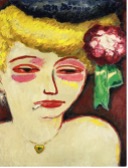
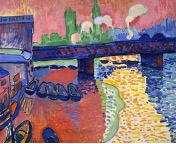

Expressionism
Key Dates: 1905–1925
Characteristics: Strong colour; distortion; abstraction; social critique; alienation
Key Artists: Franz Marc, Ernst Ludwig Kirchner, Max Beckmann
Rather than depicting the objective reality in a design work, the artist style of expressionism attempted to arouse the subjective emotions and responses from the objects and events. This aim is accomplished through distortion, exaggeration, primitivism, and fantasy and also through the vivid, jarring, violent, or dynamic application of formal elements. Expressionism originated mainly in Germany, in 1910, influencing more than just the fine arts but also dance, cinema, literature and the theatre. Take a look at the following examples of Expressionism.

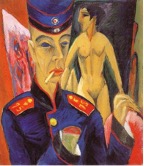
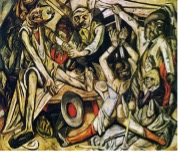
Cubism
Key Dates: 1908–1914
Characteristics: Flattened volume; confused perspective; collage; multiple viewpoint; still life; analytic; synthetic
Key Artists: Pablo Picasso, Georges Braque, Juan Gris
The Cubism art movement changed the artistic approach. It began in Paris around 1907 and was invented by Pablo Picasso and Georges Braque. Centuries of traditions were broken by the artists' Cubist paintings by rejecting the traditional techniques of a single viewpoint. This style was emphasised fragmentation, and objects were viewed from several different viewpoints simultaneously. It gave a three-dimensional effect on a two-dimensional plane. Cubism is often divided into two phases:
- The Analytic phase (1907–1912). This initial phase attempted to depict objects as the mind perceives them
- The Synthetic phase (1913 through the 1920s). The Synthetic phase featured works that were composed of fewer and simpler forms, in brighter colours. Collage was also first used in this phase.
The following images include some examples of Cubism.
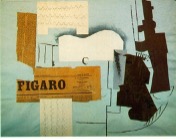
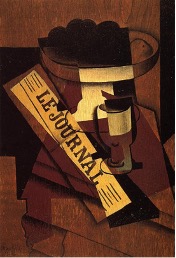
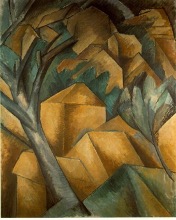
Dada
Key Dates: 1916–1920
Characteristics: Ready-mades; destruction; liberation; chance; nonsense; anti-bourgeois; witty; nihilistic
Key Artists: Hans Arp, Hugo Ball and Tristan Tzara.- Zurich Marcel Duchamp and Picabia –Paris/New York
An international movement among European artists and writers, characterised by a spirit of anarchic revolt. Dada was a theatrical cabaret manifestation, that celebrated the absurd, nonsense poetry, ridiculous costumes, raucous nonsensical performances. It was out to shock! The French poet, Tristan Tzara, began the movement whilst in Zürich. He thrusted a penknife into the pages of a dictionary to randomly find a name for the movement. The movement’s other main centres were in Paris, Berlin and New York.
While perhaps ludicrous, the Dada artists were fuelled by disillusion and moral outrage at the unprecedented carnage of World War I. This movement was aimed to shock people out of complacency, typically generating feelings of uneasiness through their artwork. In addition to being anti-war, Dada was also anti-bourgeois and had political affinities with the radical left.
The Dada movement primarily involved visual arts, literature, poetry, art manifestos, art theory, theatre, and graphic design. The movement strongly influenced Pop Art, which was sometimes called Neo-Dada. The following designs were made famous in the Dada period.

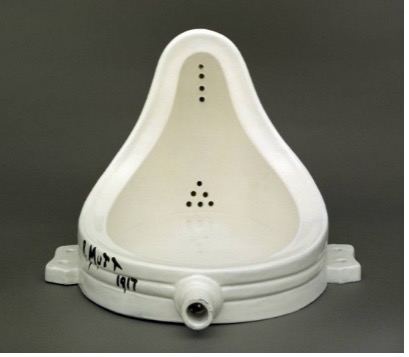
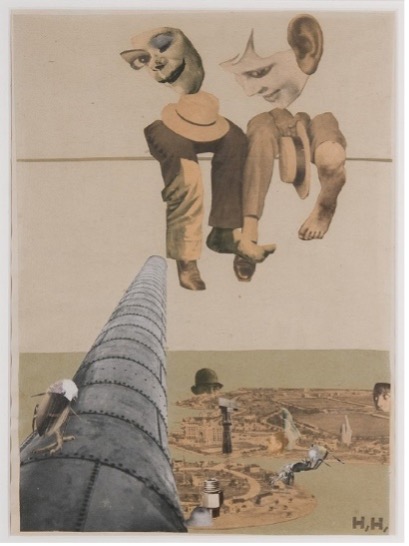
Futurism
Key Dates: 1909–1944
Characteristics: Speed; energy; aggression; lines; urban; new technology; weapons
Key Artists: Filippo Tommaso Marinetti, Giacomo Balla, Umberto Boccioni
The Futurist art movement, an Italian avant-garde movement was launched by the Italian poet Filippo Marinetti. The style of this movement was inspired by technology and modernism. This movement grew rapidly and was at its strongest from 1909 until the first World War. Futurism portrayed the dynamic character of 20th-century life, glorified war and the machine age, and favoured the growth of fascism. 5
Painters in this movement wanted to portray sensations as a…
“synthesis of what one remembers and of what one sees’’ The Exhibitors to the Public
..and to capture what they called the ‘force lines’ of objects. Take a look at the following image slides to show examples of Futurism.
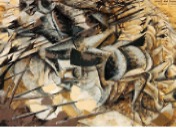
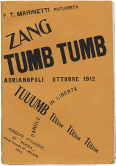

Neo-Plasticism (De Stijl)
Key Dates: 1917–1931
Characteristics: Grids; primary colours; black and white; spiritual order
Key Artists: Piet Mondrian, Theo van Doesburg, Gerrit Rietveld
A Dutch art movement advocating pure abstraction and simplicity where the forms were reduced to horizontals and verticals. Colour was stripped back to the primary colours, along with black and white. The main visual artist Mondrian wrote an essay titled ‘Neo-Plasticism in Pictorial Art’ in which he set out his ideas for this new restrictive philosophy of design. Despite being a comparatively minor short-lived 20th. Century art movement, it has like Dada, had profound and continuing influence. See the following examples of Neo-Plasticism.
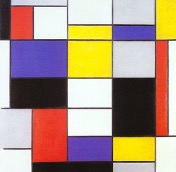
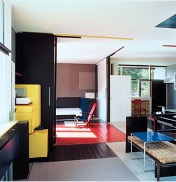

Bauhaus
Key Dates: 1919–1930
Characteristics: Art; design; mass-produced goods; total work of art
Key Artists: Wassily Kandinsky, Paul Klee, László Moholy-Nagy
The Bauhaus is considered the most important early 20th Century School of Art and Design. Under the direction of its first director Walter Gropius, the school tried to marry the fine arts with technology. Subsequent directors pushed the school more toward an architect. Bauhaus style is characterised by its severely economic, geometric design and by its respect for materials. Teaching at the school concentrated on functional craftsmanship and students were encouraged to design with mass-produced goods in mind. The school existed in three German cities:
- Weimar (1919 to 1925). The director of this school was Walter Gropius
- Dessau (1925 to 1932). The director of this school was Hannes Meyer
- Berlin (1932 to 1933). The director of this school was Ludwig Mies van der Rohe
Slide to view the image of the Bauhaus school in Dessau and Bauhaus designs.
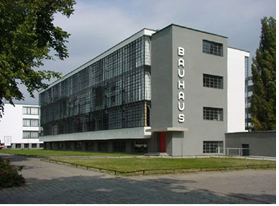
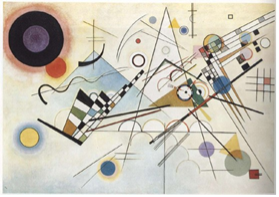

Surrealism
Key Dates: 1920–1930
Characteristics: The unconscious; dreams; the irrational; automatism; juxtaposition; eroticism
Key Artists: Max Ernst, Salvador Dalí, René Magritte
A literary and art movement founded in Paris in 1924 by André Breton. His Manifesto of Surrealism was dedicated to expressing the imagination as revealed in dreams, free of the conscious control of reason and convention. It originated in the late 1910s and early 1920s as a literary movement that experimented with a new mode of expression called automatic writing, or automatism. This movement sought to release the unbridled imagination of the subconscious. 6
Surrealism inherited its irrational sensibility from the Dada movement. However, it was more light-hearted in comparison. Similarly, to the Dada movement, Surrealism was formed by the emerging theories of our perceptions of reality.
The most prevalent theory from this epoch was Sigmund Freud's psychoanalytic theory of personality. His theory influenced many artists as it defines the unconscious mind as a reservoir of thoughts, feelings, memories and desires that are outside of one's conscious awareness. Take a look, at some memorable designs in Surrealism.
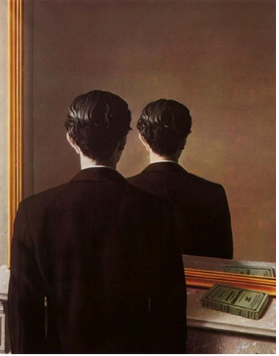

Foundation / Artists Rights Society (ARS), New York
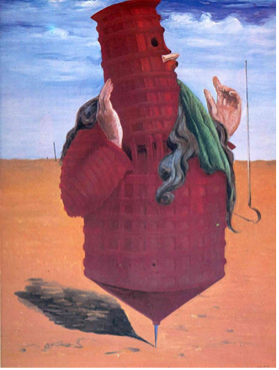
Art Deco
Key Dates: 1920–1930
Characteristics: Geometric shapes; abstraction; simplification; technology; decorative,
Key Artists: Tamara de Lempicka, Jean Dupas, A.M. Cassandre.
The name Art Deco came from the 1925 Exposition, ‘Internationale des Arts Decoratifs Industriels et Modernes’, held in Paris, which celebrated living in the modern world. Paris wanted to re-assert its position as the Western World’s capital in art and design after WW1 and Art Deco was the new style to do so! Art Deco was an art, architecture, interior design, fashion, jewellery and object d’arte movement with a strong graphic design basis. Cassandre was the most significant graphic designer of the era. There were two iterations of Art Deco. The first was ‘Hollywood’ glamour, beautiful craftsmanship, and exotic expensive materials. The second, the ‘Streamlined’ version, developed after the Great Depression of the late 1920s, was a little less glamourous, a little less exotic and many of the designs were influenced by the design and aesthetic of the Ocean Liner.
Have a look at some examples of Art Deco designs in both art and interior design. Take note of the image of a modern-day restaurant and how the interior designers have used art deco’s rich colours and decadent detail work.
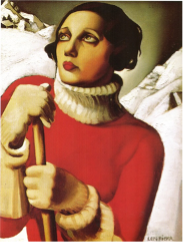
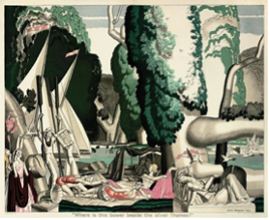
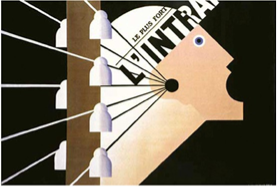
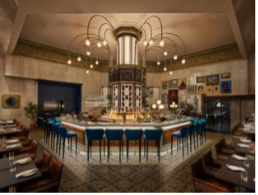
Abstract Expressionism
Key Dates: 1940–1960
Characteristics: Universal order; action; unconscious symbols; stillness; colour field
Key Artists: Jackson Pollock, Willem de Kooning, Franz Kline
The movement is marked by its use of brush strokes and texture, the embracing of chance and the frequently massive canvases. These were all employed to convey powerful emotions through the glorification of the act of painting itself. There are two distinct styles in Abstract Expressionism.
- Action Painting-where the artist’s gesture is evidence of the actual process of the work’s creation
- Early Colour Field Painting- where Rothko, Newman used simplified canvases to express a religious or mediative expression
The movement was enormously successful both critically and commercially. As a result of this, New York became the centre for contemporary art, replacing Paris. This was also the years of the Cold War between America and Russia, and the success of this art movement was used as a political symbol of the personal and political freedom of the American artists in comparison to Russian artists. The repercussions of this extraordinarily influential movement can still be felt more than 30 years after its heyday. The following images are examples of Abstract Expressionism.
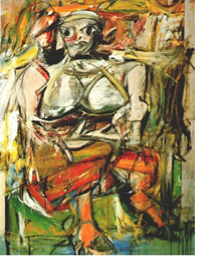
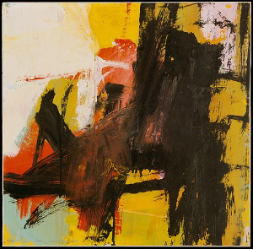
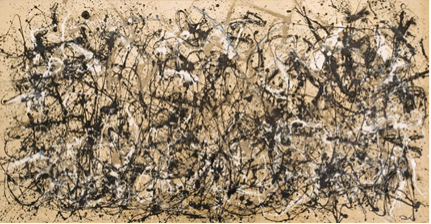
Pop Art
Key Dates: 1950–1960
Characteristics: Everyday objects; mass-produced; commercial techniques; witty
Key Artists: Richard Hamilton, Andy Warhol, Roy Lichtenstein
This movement was marked by a fascination with popular culture reflecting the affluence in post-war society. It was most prominent in American art, but the movement began in Britain, with artists such as Richard Hamilton, Eduardo Paolozzi and Peter Blake. In celebrating everyday objects such as soup cans, washing powder, comic strips and soda pop bottles, the movement turned the commonplace items into icons.
Pop Art is a direct descendant of the Dada movement in the way that it mocks the established art world by appropriating images from the street, the supermarket, the mass media, and presents it as art. See the following images of Pop Art.

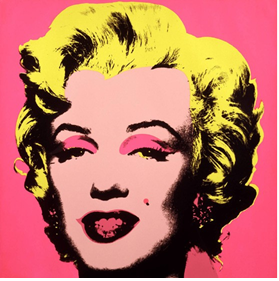
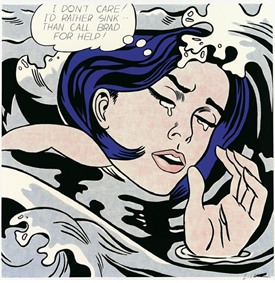
Photorealism
Key Dates: 1960–1970
Characteristics: Detailed; everyday scenes; camera; mechanical
Key Artists: Chuck Close, Richard Estes, Duane Hanson
A figurative movement that emerged in the United States and Britain in the late 1960s and 1970s. The subject matter, usually everyday scenes, is portrayed in an extremely detailed, exacting style. It is also called superrealism, especially when referring to sculpture. Artists attempted to reproduce what the camera could record. 7
Photorealism grew out of the Pop and Minimalism movements that preceded it. Like Pop artists, the Photorealists were interested in breaking down hierarchies of appropriate subject matter by including everyday scenes of commercial life such as cars, shops, and signage. The following slide of images are examples of Photorealism. 8
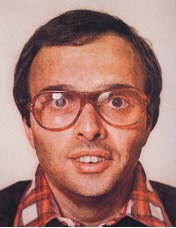
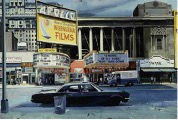

Minimalism
Key Dates: 1962 onwards
Characteristics: Simplicity; repetition; austerity; sterile
Key Artists: Dan Flavin, Richard Morris, Carl Andre
Minimalism is a term used in the 20th century, in particular from the 1960s, to describe a style characterised by the following three key features:
- An impersonal austerity
- Plain geometric configurations
- Industrially processed materials.
Signs of any personal expressivity is removed and not the focal point of this movement. Minimalism describes the paintings and sculptures that thrive on simplicity in both content and form. Minimalism aims to allow the viewer to experience the work more intensely without the distractions of elements such as composition and theme. See the following three examples of Minimalism.

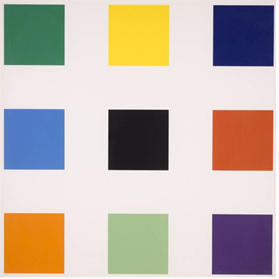
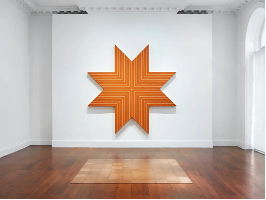
Op Art
Key Dates: 1960 onwards
Characteristics: Pattern; illusion; movement; vibration; contrasting colours
Key Artists: Bridget Riley, Richard Anuszkiewicz, Victor Vasarely
Op Art is the term used as an abbreviation of ‘optical art’. It refers to paintings and sculptures that exploit the illusions or optical effects of perceptual processes such as swelling or vibrating. After ‘The Responsive Eye’ exhibition at the Museum of Modern Art in New York in 1965, the term “Op Art” became a household name, and the style was soon appropriated by fashion designers and high street stores.
Examples of Op Art:

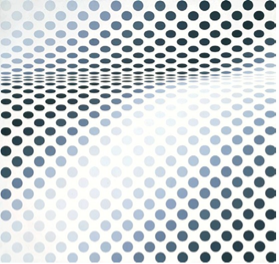
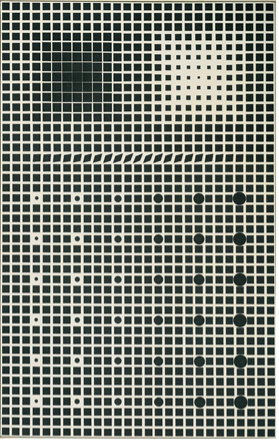
Postmodernism
Key Dates: 1960 stopped around 2000
Characteristics: Eclecticism; anti-corporate; deconstruction; irony; mass media
Key Artists: Barbara Kruger, Jeff Koons, Damien Hirst
Postmodernism refers more to a broad collection of ideas and cultural trends than an actual artistic movement. Critics and theorists over the past four decades have offered differing views on when postmodernism began, and some have even argued that it is simply a groundless concept concocted by academics.
There are several characteristics that lend art to being postmodern. These include:
- bricolage
- the use of words prominently as the central artistic element
- collage
- simplification
- appropriation
- performance art
- the recycling of past styles
- themes in a modern-day context.
Postmodernism can also include characteristics that break up the barrier between fine and high arts and low art and popular culture. Have a look at the following examples of Postmodernism art and design. 9
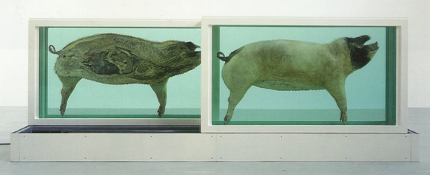
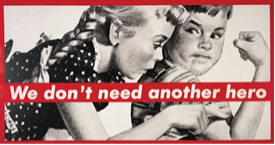
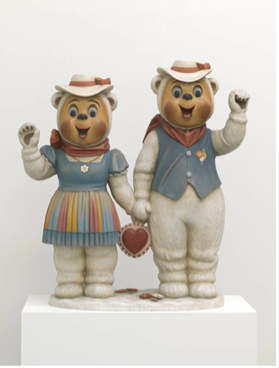
In the late 20th century, it was still easy to recognise which decade the design trends came from. For instance, designs from the 1970s, 1980s and 1990s had distinct differences that set them apart. The lines become a little blurry in the 21st century. Digital technology is much to blame, as it has revolutionised the way designers share ideas, draw inspiration from and use their skills. It can become difficult to determine what is actually current in this new era. Today’s digital revolution shows evidence that current trends are really any style of design created today. Designers today will often refer to historical design and theories, at times combining a few to create a unique design. Other designers focus on reinventing ways to become more engaging, communicate clearer and at times will aim to be an innovator in the creative industry.
The following are examples of a few well-known designers that are relevant in today’s world and hitting milestones with current design trends.
- Jessica Walsh- And Walsh
- Stefan Sagmeister- Sagmeister and Walsh
- David Carson- David Carson Design
- Philippe Starck- Starck
- Jonathan Ives- Dezeen- Jony Ives
Today's designers have access to limitless tools and technology, allowing them to produce a vast range of graphic and typographic styles. Designers can broaden their perspectives and improve their talents by learning about the history and theory of design. As a result, they can produce a far more refined body of work in their current practices.
In this topic, we focused on Design History and Theory. You have learnt about:
- Where did design begin
- The Industrial Revolution
- Historical design movements
- Current design trends.
